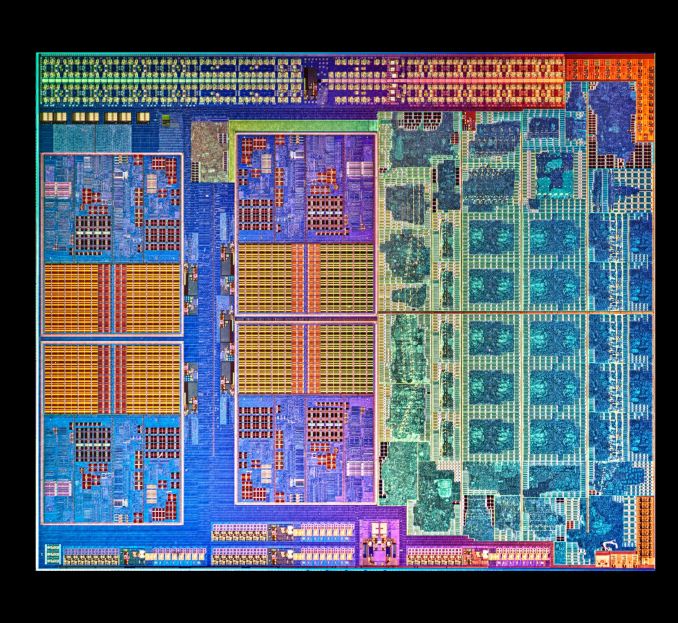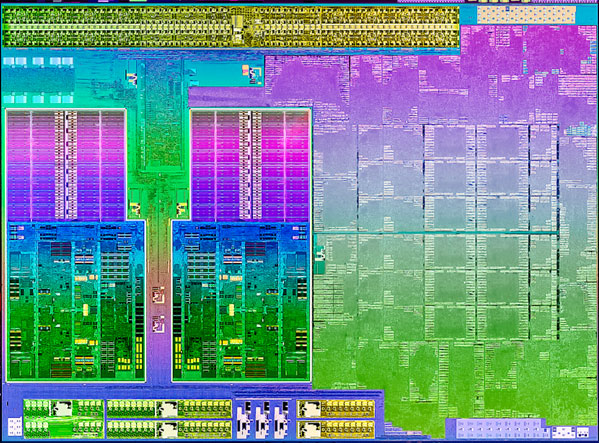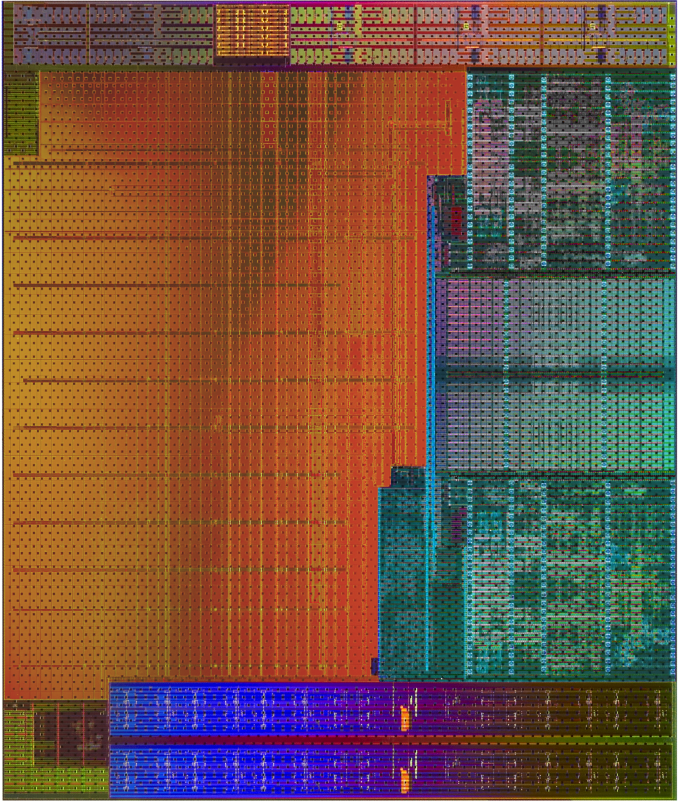AMD Kaveri Review: A8-7600 and A10-7850K Tested
by Ian Cutress & Rahul Garg on January 14, 2014 8:00 AM ESTLlano, Trinity and Kaveri Die: Compared
AMD sent along a high res shot of Kaveri's die. Armed with the same from the previous two generations, we can get a decent idea of the progression of AMD's APUs:
Llano, K10 Quad Core
Trinity and Richland Die, with two Piledriver modules and processor graphics
Kaveri, two modules and processor graphics
Moving from Llano to Trinity, we have the reduction from a fully-fledged quad core system to the dual module layout AMD is keeping with its APU range. Moving from Richland to Kaveri is actually a bigger step than one might imagine:
| AMD APU Details | ||||
| Core Name | Llano | Trinity | Richland | Kaveri |
| Microarch | K10 | Piledriver | Piledriver | Steamroller |
| CPU Example | A8-3850 | A10-5800K | A10-6800K | A10-7850K |
| Threads | 4 | 4 | 4 | 4 |
| Cores | 4 | 2 | 2 | 2 |
| GPU | HD 6550 | HD 7660D | HD 8670D | R7 |
| GPU Arch | VLIW5 | VLIW4 | VLIW4 | GCN 1.1 |
| GPU Cores | 400 | 384 | 384 | 512 |
| Die size / mm2 | 228 | 246 | 246 | 245 |
| Transistors | 1.178 B | 1.303 B | 1.303 B | 2.41 B |
| Power | 100W | 100W | 100W | 95W |
| CPU MHz | 2900 | 3800 | 4100 | 3700 |
| CPU Turbo | N/A | 4200 | 4400 | 4000 |
| L1 Cache |
256KB C$ 256KB D$ |
128KB C$ 64KB D$ |
128KB C$ 64KB D$ |
192KB C$ 64KB D$ |
| L2 Cache | 4 x 1MB | 2 x 2 MB | 2 x 2 MB | 2 x 2 MB |
| Node | 32nm SOI | 32nm SOI | 32nm SOI | 28nm SHP |
| Memory | DDR-1866 | DDR-1866 | DDR-2133 | DDR-2133 |
Looking back at Llano and Trinity/Richland, it's very clear that AMD's APUs on GF's 32nm SOI process had a real issue with transistor density. The table below attempts to put everything in perspective but keep in mind that, outside of Intel, no one does a good job of documenting how they are counting (estimating) transistors. My only hope is AMD's transistor counting methods are consistent across CPU and GPU, although that alone may be wishful thinking:
| Transistor Density Comparison | ||||||||
| Manufacturing Process | Transistor Count | Die Size | Transistors per mm2 | |||||
| AMD Kaveri | GF 28nm SHP | 2.41B | 245 mm2 | 9.837M | ||||
| AMD Richland | GF 32nm SOI | 1.30B | 246 mm2 | 5.285M | ||||
| AMD Llano | GF 32nm SOI | 1.178B | 228 mm2 | 5.166M | ||||
| AMD Bonaire (R7 260X) | TSMC 28nm | 2.08B | 160 mm2 | 13.000M | ||||
| AMD Pitcairn (R7 270/270X) | TSMC 28nm | 2.80B | 212 mm2 | 13.209M | ||||
| AMD Vishera (FX-8350) | GF 32nm SOI | 1.2B | 315 mm2 | 3.810M | ||||
| Intel Haswell 4C (GT2) | Intel 22nm | 1.40B | 177 mm2 | 7.910M | ||||
| NVIDIA GK106 (GTX 660) | TSMC 28nm | 2.54B | 214 mm2 | 11.869M | ||||
If AMD is indeed counting the same way across APUs/GPUs, the move to Kaveri doesn't look all that extreme but rather a good point in between previous APUs and other AMD GCN GPUs. Compared to standalone CPU architectures from AMD, it's clear that the APUs are far more dense thanks to big portions of their die being occupied by a GPU.













380 Comments
View All Comments
DanNeely - Tuesday, January 14, 2014 - link
This is the first I've heard that Excavator will be the end of the line for the current AMD core. Is there any information about what's coming next publicly available yet?JDG1980 - Tuesday, January 14, 2014 - link
It's all speculation because AMD hasn't released any roadmaps that far in advance. If I had to guess, I'd say they will probably beef up the "cat" cores (Bobcat -> Jaguar, etc.) and use that as their mainstream line. That would be similar to what Intel did when they were faced with a situation like this - they scaled up the mobile Pentium M to become the Core 2 Duo.jabber - Tuesday, January 14, 2014 - link
The great shame of these chips is the real market they should be selling in will never take off. These are perfect all round chips for those folks that buy a family PC in the usual PC mega store. That family PC would be your usual Compaq/Acer desktop with a decent enough Intel chip in it but the crappy Intel IGP only.But as AMD never advertises to these people (the people who should be buying this stuff) they will never buy them. The demand will never appear. They have heard of Intel, they hear the Intel jingle on the TV several times a week. But AMD? Never heard of them, they cant be any good.
Has anyone at Anandtech ever got round to interview the lazy idiot in the AMD marketing dept? Does AMD really have a marketing dept?
AMD, sometimes you do have to push the boat out and make the effort. Really stick it under ordinary peoples noses. Don't bother keep brown-nosing the tech review sites cos most of their readers don't buy your stuff anyway.
UtilityMax - Tuesday, January 14, 2014 - link
AMD can't market the APUs directly to the average consumers. They just buy what the PC mega-store sells to them. AMD should convince the OEMs, and that is _really_ hard. First is the issue of Intel quasi-monopoly. Intel always browbeat the major EOMs to ignore AMD. Even after losing the lawsuit, I think this effect still exists. And then next issue is that, your typical average consumer does not play on PC. They play on consoles. In fact, hardly anyone buys a PC box these days. Everyone buys laptops, and AMD's strategy there is just as weak.ThreeDee912 - Tuesday, January 14, 2014 - link
They tried to get OEMs to put Llano chips into "thin and light" laptops, but Intel kind of beat them with their Ultrabook marketing.At least AMD kind of "won" the console wars by getting their CPUs into both the PS4 and XBone.
xdesire - Tuesday, January 14, 2014 - link
Sorry but i read it like this: this is another piece of sht hardware which is YET another disappointment for their fans. I owned many of their CPUs GPUs and stuff but enough is enough. They have been laying their a**es off for SO long and couldn't even make an improvement on their crap stuff. So, is this THE Kaveri we were promised for so long? I supported them in their worst days by buying their products, hoping to see them come back in the game BUT no, they are being lazy and don't improve sht..jabber - Tuesday, January 14, 2014 - link
Dear AMD marketing Dept, the above post signifies what I said in the last part of my last post.This is not the market/customer you are looking for!
jnad32 - Tuesday, January 14, 2014 - link
Actually a 30% performance improvement seems pretty amazing to me. Also please try and remember that all these tests are done with very early drivers. We all know AMD takes forever to get there drivers in line. I wouldn't personally worry about numbers for the next couple of months. BTW, what were you expecting from an APU? Core i5? HA! I am a massive AMD fan, but we all know that wasn't even possible. What I really want to know is where is my 8 core Steamroller chip.JDG1980 - Tuesday, January 14, 2014 - link
I was hoping for IPC in line with at least Nehalem. The low IPC is really killing the "construction equipment" cores, and it's increasingly looking like an unfixable problem. If Steamroller could have brought ~30% IPC gains as was initially rumored, then that would have been a good sign, but at this point it seems they'd be better off taking their "cat" cores and scaling them up to desktop levels, and dropping the module architecture as a failed experiment.silverblue - Tuesday, January 14, 2014 - link
A "construction equipment" (thanks) module actually gets an impressive amount of work done when taxed. The concensus has been to make software think a module is a single core with HT. I imagine that the cores will be fed better in single threaded workloads in that circumstance.I also imagine that a heavily threaded workload will extract the very best from the architecture now the MT penalty is gone.
One question about the review scores - all the testing was done on Windows 7 64-bit SP1 with the Core Parking updates applied. Would using Windows 8 or 8.1 make any real difference to the results or would it just benefit both AMD and Intel?